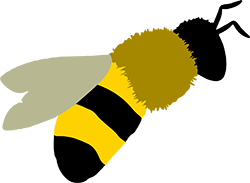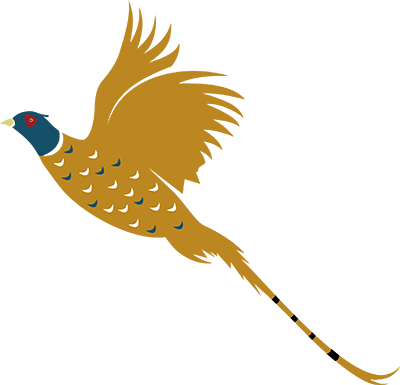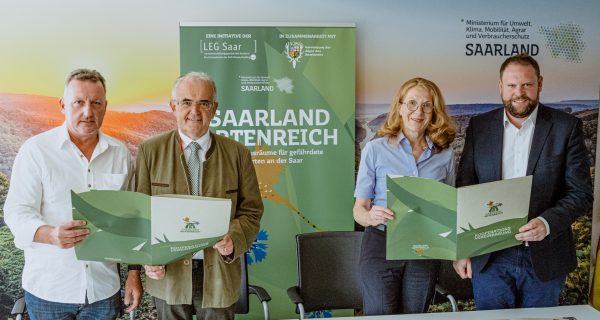SAARLAND ARTENREICH
NEW HABITATS FOR ENDANGERED ANIMAL SPECIES AROUND THE SAAR
» Go to Video
 The protection of biodiversity is an imperative. It is an obligation to nature, and also to the next generations. Therefore, we take precautionary measures for an intact and livable environment. Given the fact that agricultural land is plowed and mulched in spring, public spaces are mostly mowed and more and more private gardens are reduced to stone surfaces, a compensation should be created. Specifically, this means the provision of suitable areas and their supply with species-rich seeds in order to sustain the life of as many plants and animal species as possible. LEG Saar, the Ministry for the Environment, Climate, Mobility, Agriculture and Consumer Protection (MUKMAV) and the Vereinigung der Jäger des Saarlandes (VJS) will pool their commitment to biodiversity in the future. In the state-wide `Saarland Artenreich` project, they are raising awareness of the important theme of biodiversity and expand the already existing contribution to species-rich landscapes.
The protection of biodiversity is an imperative. It is an obligation to nature, and also to the next generations. Therefore, we take precautionary measures for an intact and livable environment. Given the fact that agricultural land is plowed and mulched in spring, public spaces are mostly mowed and more and more private gardens are reduced to stone surfaces, a compensation should be created. Specifically, this means the provision of suitable areas and their supply with species-rich seeds in order to sustain the life of as many plants and animal species as possible. LEG Saar, the Ministry for the Environment, Climate, Mobility, Agriculture and Consumer Protection (MUKMAV) and the Vereinigung der Jäger des Saarlandes (VJS) will pool their commitment to biodiversity in the future. In the state-wide `Saarland Artenreich` project, they are raising awareness of the important theme of biodiversity and expand the already existing contribution to species-rich landscapes.
THE SAARLAND ARTENREICH PROJECT PROMOTES NATIVE SPECIES,
thus contributing to the creation, preservation and strengthening of biodiversity in Saarland. Specifically, this includes providing suitable areas and equipping them with species-rich, regional seeds in order to ensure the survival of as many plant and animal species as possible.
In cooperation with hunters from the region and communities, areas particularly suitable for creating flowering landscapes rich in insects are identified. For this purpose, the landowners are provided free of charge with a special regional `habitat seed mixture` made from numerous wild flowers and cultivated plants . In return, they agree to sowing the seed and setting aside their areas for the coming years. The seeds sown consist of roughly 60 different regional wildflower species and cultivated plants tailored to our climatic conditions and the needs of local animals and insects.
The resulting flowering areas (at least 21 meters wide) provide food and shelter for many animal species, from wild bees and other insects to pheasants, wild rabbits, numerous endangered species of wild birds and others. They should consist of at least three different, strip-form vegetation types (field margins, flowering areas, light field areas, optional grassy protective strips, optional protective strips, optional open areas). The cultivation in stripes thus creates new structures that had existed for centuries in smallholding agriculture and provide optimal habitats for the soil-breeding species. The seeds are handed over by the local hunters which act as a link between the project partners and the area owners.

WHAT HAS BEEN ACHIEVED SO FAR
The results of the last few years are remarkable. In all Saarland districts, more than 90 hectares of new flowering landscapes have emerged within two years. In the Saarlouis district alone, model biotopes were created in various natural areas on a total of roughly 250 hectares. Last year, a mixture of the `Habitat 1` seed (particularly suitable for insects, birds, small wild game including roe deer), clover, sunflowers and an annually flowering mix was sown.
The flowering areas created that way provide shelter and food for many endangered animal species. This includes many insects, such as the native wild bee and butterflies, but also partridge, pheasant, rabbit and various bird species as e. g. the skylark. For example, from 2018 to 2021, the total number of registered bird species in these project areas increased from 38 to 75.
-
» Go to photos

` This cooperation agreement is an important contribution to achieve more biodiversity throughout the area. LEG Saar and VJS are welcome partners for us to bring about local acceptance for the development of flowering landscapes and to ensure implementation together with farmers. That’s how species protection works – together on site, for the benefit of people and nature.`
-Petra Berg, Minister for the Environment, Climate, Mobility, Agriculture and Consumer Protection
» Ministerium für Umwelt, Klima, Mobilität, Agrar und Verbraucherschutz

` One of our goals is to raise public awareness of the topic of biodiversity. After all, it is an essential part of our region´s development. Accordingly, the promotion of habitats for endangered animal species is an important concern and also task for us. Together with the municipalities and the local farmers, we want to be pioneers in creating an insect-rich cultural landscape of relevance to biodiversity.`
–LEG Saar Managing Director Valentin Holzer

` We support species conservation projects throughout the region and, as Saarland hunters, are contributing our part enthousiastically. Because hunting is a cultural asset that has grown historically over thousands of years. And today, hunting does not just mean obtaining sustainable high-quality, healthy food. Above all, hunting serves to preserving nature and thus fulfills an important social requirement of our time.`
-Landesjägermeister Josef Schneider
» Vereinigung der Jäger des Saarlandes


